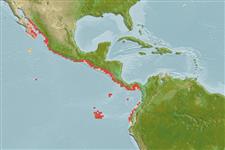Environment: milieu / climate zone / depth range / distribution range
Sinh thái học
Biển; Mức độ sâu ? - 70 m (Ref. 96339), usually ? - 50 m (Ref. 11035). Tropical; 28°N - 3°S, 112°W - 78°W (Ref. 54686)
Eastern Pacific: Santa Rosalita, Pacific coast of Baja, California, Mexico southward to Punta Sal and Punta Picos, Peru. (Earlier works probably combined data for Opisthonema bulleri and Opisthonema medirastre). Range is extended northwards to San Pedro, California (Ref. 35601). Rare on outer coast of Baja California Sur (Ref. 35601).
Bộ gần gũi / Khối lượng (Trọng lượng) / Age
Maturity: Lm ? range ? - ? cm
Max length : 30.0 cm TL con đực/không giới tính; (Ref. 55763); common length : 22.0 cm SL con đực/không giới tính; (Ref. 9291); Khối lượng cực đại được công bố: 261.36 g (Ref. 124487)
Các tia vây lưng cứng (tổng cộng) : 0; Các vây lưng mềm (tổng cộng) : 13 - 21; Tia cứng vây hậu môn: 0; Tia mềm vây hậu môn: 12 - 23. The filamentous last dorsal fin ray distinguishes it from members of any other eastern Pacific clupeoid genus. Separated from eastern Pacific Opisthonema species by having 63 to 110 lower gill rakers in fishes over 14 cm standard length.
Usually occur near the surface of coastal and offshore waters, down to over bottom of continental shelf (Ref. 11035). Form dense schools. Apparently the most abundant of the eastern Pacific species of Opisthonema. Feed on phytoplankton (dinoflagellates and diatoms). Oviparous, with planktonic eggs and larvae (Ref. 35601). It is reduced to fish meal (Ref. 9291). Oil may be extracted (Ref. 9291). May be canned (Ref. 9291).
Whitehead, P.J.P., 1985. FAO Species Catalogue. Vol. 7. Clupeoid fishes of the world (suborder Clupeoidei). An annotated and illustrated catalogue of the herrings, sardines, pilchards, sprats, shads, anchovies and wolf-herrings. FAO Fish. Synop. 125(7/1):1-303. Rome: FAO. (Ref. 188)
IUCN Red List Status (Ref. 130435: Version 2024-1)
Threat to humans
Harmless
Human uses
Các nghề cá: tính thương mại cao; mồi: occasionally
Các công cụ
Special reports
Download XML
Các nguồn internet
Estimates based on models
Preferred temperature (Ref.
123201): 21.4 - 29, mean 27 °C (based on 86 cells).
Phylogenetic diversity index (Ref.
82804): PD
50 = 0.5312 [Uniqueness, from 0.5 = low to 2.0 = high].
Bayesian length-weight: a=0.00676 (0.00395 - 0.01157), b=3.06 (2.91 - 3.21), in cm total length, based on LWR estimates for this species & (Sub)family-body (Ref.
93245).
Mức dinh dưỡng (Ref.
69278): 2.9 ±0.28 se; based on food items.
Thích nghi nhanh (Ref.
120179): Chiêù cao, thời gian nhân đôi của chủng quần tối thiểu là dưới 15 tháng (K=0.22-0.5).
Prior r = 0.43, 95% CL = 0.28 - 0.64, Based on 2 full stock assessments.
Fishing Vulnerability (Ref.
59153): Low vulnerability (25 of 100).
Climate Vulnerability (Ref.
125649): Moderate vulnerability (37 of 100).
Nutrients (Ref.
124155): Calcium = 199 [90, 362] mg/100g; Iron = 1.94 [1.10, 3.34] mg/100g; Protein = 18.6 [17.5, 19.7] %; Omega3 = 0.37 [0.21, 0.67] g/100g; Selenium = 48.5 [23.7, 99.5] μg/100g; VitaminA = 26.8 [9.3, 78.7] μg/100g; Zinc = 1.41 [0.97, 2.09] mg/100g (wet weight);
